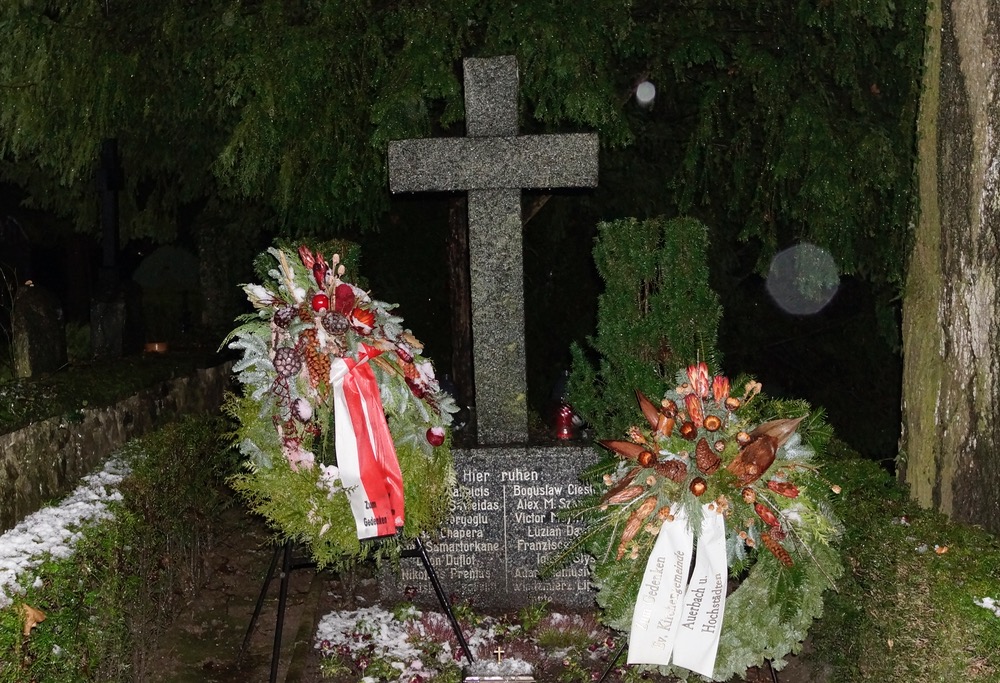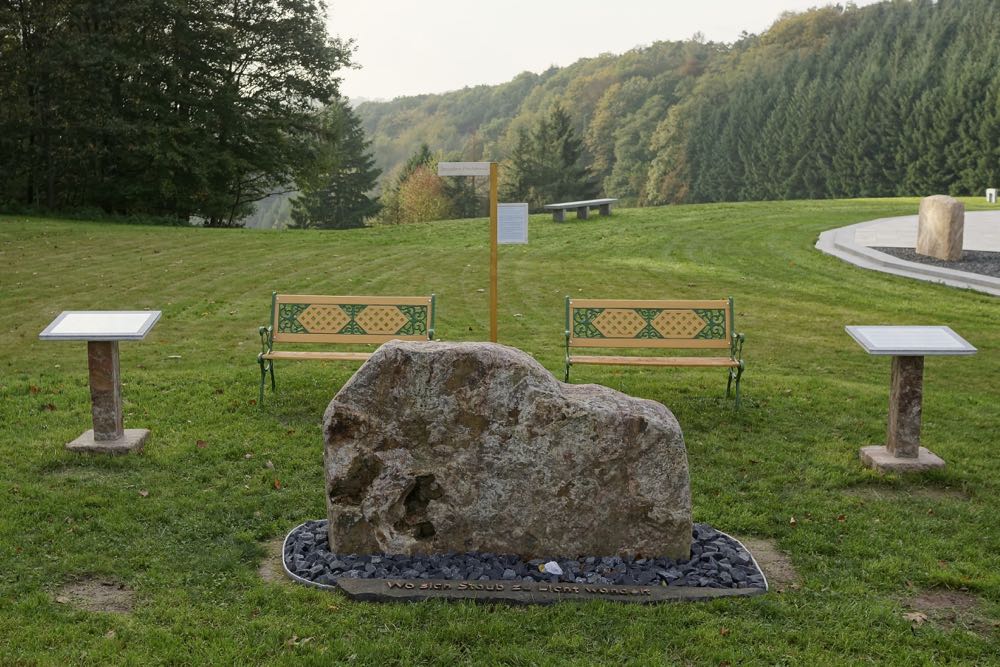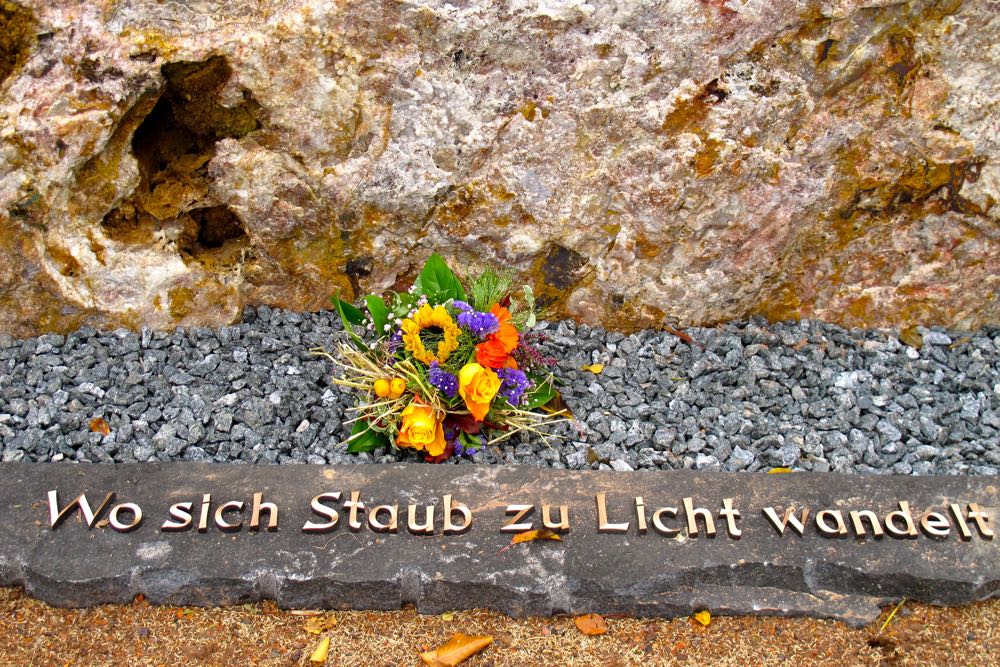A reference to the darkest chapter of recent German history can be found in Hochstädten in the form of a former armaments factory, which is listed in the Israeli Yad Vashem memorial site as the "Auerbach subcamp" of Natzweiler-Struthof concentration camp. Here, towards the end of World War II, displaced Greeks and concentration camp prisoners were used as forced laborers. For the forced labourers and this local past, the Stone of Encounter was placed next to the Friedensmal above Hochstädten in 2012. This memorial stone reminds us, in the context of war and a breach of civilisation, not to allow ourselves to be captured by ideologies and to preserve the positive "Idea of Jerusalem" (inscription on the stone: Yerushalayim - a call full of love for freedom for mankind…). "Yerushalayim" here stands as a metaphor with reference to the Judeo-Christian heritage of our culture for striving for a positive vision of the future precisely because of the suffering and evil in the world. Information about the entire memorial site dedicated to this positive vision of the future can be found here.
The Greek forced labourers
The sentence “Where dust is turned to light” on the slate stone beneath the 12th commemorative stone, the Stone of Encounter, was taken from a poem by Nelly Sachs “Ihr Zuschauenden” [You who watched, original poem in German]. The view west from this side of the Stone of Encounter is into the Hochstaedter Valley. Here, in subterraneous mine tunnels, an arms factory with a research and development institute was located towards the end of the Second World War. The subterraneous location should protect the site from allied bombing. The operations were headed by the Heymann company with significant financial support by the SS. A majority of the 129 Greek forced labourers stationed in neighbouring Auerbach had to march to Hochstädten every morning (reference, you can find more information on the Greek forced labourers by following the link). They had to expand the network of tunnels for the institute in wretched conditions. The Greek men were captured by the German military on August 17th, 1944 during the Razzia of Kokkinia (today Nikea, near Athens) and subsequently brought to Germany to perform forced labour.Remembering the prisoners who died in Hochstädten
Here, 22 victims lie buried, Greek forced labourers and also prisoners of the local subcamp of Natzweiler-Struthof: Stergies Kalleicis, Theodores Saweidas, Trifon Georgoglu, Josef Chapera, Franz Samartorkane, Leon Duflot, Nikolaos Prento, Stanislaus Cyarskij, Boguslav Ciesiel, Alex M. Szamokine, Victor Msyichowski, Luzian Dawiko, Franziscek Diasek, Ignatz Stys, Adam Namusiwitsch, Wlodzimierz Lipowski, Leon Quflot, as well as six further, anonymous men.
A subcamp of Natzweiler-Struthof / Alsace
Concentration camp prisoners were used as laborers to operate the various tools for technical development and for construction work. According to a witness of that time (Mr Bitsch, Hochstädten), they constructed the framings of three further barracks in Hochstädten, in the so-called Sauloch. One barrack, situated behind the current tennis court in Hochstädten, was already completed and fitted with the necessary inventory for technical development (drawing boards, drawing rolls...). One barrack was constructed further back, in the woods. It served as a communal barrack for the concentration camp prisoners and guards. The activities of the Heymann company originally took place in Darmstadt. However, operations moved to Bensheim-Hochstädten at the end of September 1944 due to allied bombings (reference, p. 39, German). The mining tunnels were used to protect against allied bombings. It is assumed that gyroscope control systems were produced here to stabilize projectiles and torpedoes. According to the witness Mr. Bitsch, the future production hall in the mine (Heymann-Saal) was still under construction. In the side corridors of the mine, however, casing components for technical systems with a diameter of approx. 10 cm were already being produced using modern machinery. After the war, the machines – above all turning lathes – were initially moved to a hall of the Fuchs craft business in Bensheim-Auerbach. According to the witness Mr. Bitsch, they were intended as war reparations for the victorious countries.
The factory was located in Hochstädten. However, the prisoners were situated in Auerbach, which is why it was operated as the subcamp “Bensheim-Auerbach” of the Natzweiler concentration camp in the Alsace. The plans initially intended to expand the Darmstadt operations to 300 prisoners (reference, p. 49 and 51, German). But this proved also to be impossible in Bensheim-Auerbach respectively Hochstädten. In October 1944, around 25 concentration camp prisoners were housed here (reference). From February 6th, 1945 at the latest, however, the camp already housed approx. 60 prisoners (references, p. 88, p. 120, German). “At one company, located in a mine in Hochstädten, approx. 20 prisoners ... worked on lathes. Around 10 camp inmates were used for exterior construction at this mine, they built an air shaft. Around 6 prisoners worked in a barrack located right next to the camp. These performed drawing activities. The others were busy chopping trees and creating barracks in the woods” (Barch B 162 / IV 419 AR 1436/68). The last secured claim on the occupancy of the subcamp comes from a list of the Dachau concentration camp, which states that 75 prisoners from the Auerbach subcamp arrived there on April 2nd, 1945 (reference). These included around 15 - 21 inmates from the Darmstadt-Grießheim subcamp, which fell under the administration of the Auerbach subcamp. This confirmed that the Auerbach subcamp had approx. 60 inmates at the time of its closing. (Please note, that this list indicates that one inmate died on the way to Dachau. It’s also probable that several inmates managed to escape during their evacuation. According to the death register of the Bensheim registry office, a total of 15 inmates died in the Bensheim-Auerbach subcamp. The Greeks are not included in this figure.)
This chart (Arno Huth, Neckarelz Concentration Camp Memorial) on the dissolution of the Natzweiler concentration camp shows the system of subcamps and the position assumed by the Bensheim-Auerbach subcamp. The subcamp was evacuated a few days before the allies arrived on March 27th, 1945. The inmates were brought to the Dachau concentration camp. There was an entire system of main and subcamps, which spanned the continent during the national-socialist rule of terror. According to a New York Times report dated March 1st, 2013, there were approximately 42,500 national-socialist camps, ghettos, and facilities with forced laborers in those areas of Europe controlled by Germany, all the way up to Russia. It would’ve been virtually impossible to find a region without a camp, according to the article (reference). Therefore, when speaking of the former subcamp Bensheim-Auerbach, it's not about highlighting the place as special because of a “dark history”. Quite the contrary, the goal is to make people aware of the extensive system of camps and how widespread and ordinary their existence was by the end of the war.
Many thanks to Mr Arno Huth of the Neckarelz Concentration Camp Memorial as well as Mr Dr Kilthau of the Zwingenberg Synagogue Association for providing the historical documents. The information to be found here was researched and published by Thomas Zieringer in 2017.

This side of the Stone of Encounter, raw and blank, faces the site of the former arms factory in Bensheim-Hochstädten, which was operated by prisoners of the Auerbach subcamp. It serves as a commemorative stone and addresses the darkest chapter of German history. This, too, is therefore an issue at this location: Bensheim and behind it the Rhine Plain are located behind the trees and the hill visible in the image above. This region was once home to blossoming Jewish life. On November 9th, 1938 and the following day, the synagogues burned, also in the cities of Speyer, Worms and Mainz – cities with a most significant Jewish past. On November 10th, also the synagogue in Bensheim burned to the ground. The Jewish congregations all over Germany, and later also far beyond the German borders, were destroyed. The Jewish Germans were displaced or murdered. The Bensheim locals “supported the state” back then. After the bombing of Darmstadt during the Second World War, the Hessian Gestapo department was moved to Bensheim (Kirchbergmorde) [Kirchberg killings].
The Stone of Encounter as the 12th commemorative stone marks the border of the site of the Friedensmal. It stands as “…a call full of love for the freedom of man”. We look at the past, remember who we truly are, and confront the present. Life happens in the present: Where do we experience war and restriction instead of peace and freedom today, in our own lives? Where can we assume responsibility for a more beautiful world? Where does our responsibility begin? A threshold of slate underneath the Stone of Encounter refers to the Friedensmal located to the right of it, with the inscription “Where dust is turned to light”. It shows visitors the way to the path inwards. The Friedensmal represents inner peace, which can be found in one’s inner core and subsequently carried outside into the world.
“You who raised no hand in murder, but who did not shake the dust from your yearning, you who halted there, where dust is turned to light” (Nelly Sachs).
Return to the overview: Place
